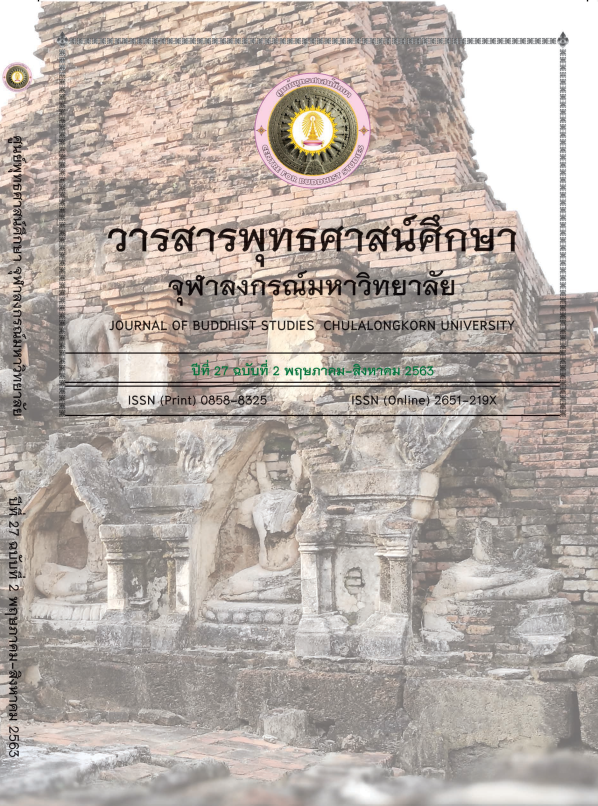An Analysis of Bhikkhuni’s vinaya as codes of conduct for women on their pursuit of enlightenment
Keywords:
the female body, the five kinds of suffering peculiar to women, Bhikkhuni Vinaya, enlightenmentAbstract
This article analyzes Bhikkhuni Pàtimokkha ((or Bhikkhuni’s vinaya) codes of monastic disciplinary rules) and passages in the Bhikkhuni Vibhanga in relation to the concept in Avenika Sutta of the five kinds of suffering specific to women which result from differences between the female and male body in biological and socio-cultural terms. In light of this concept, this article attempt to argue that Buddhism postulates a set of practices leading to the Enlightenment which takes into account of the disparity between the male and female body. It thus examines Bhikkhuni’s vinaya as codes of conduct for women on their pursuit of enlightenment which aim at coping with the women’s suffering generated by their biological body and overcoming the obstacles caused by the socio-cultural aspects of their body.
Downloads
References
ฉัตรสุมาลย์ กบิลสิงห์ ษัฏเสน. (2011). สัทธรรมปุณฑรีกสูตร. กรุงเทพมหานคร: บจก. ส่องศยาม.
ฉัตรสุมาลย์ กบิลสิงห์. (2559). ธรรมลีลา. ฉัตรสุมาลย์ : สมมติสีมารักษาพระศาสนา. มติชนสุดสัปดาห์ (ฉบับวันที่ 28 ต.ค. – 3 พ.ย. 59). สืบค้นจาก https://www.matichonweekly.com/column/article_13625
ธัมมนันทา ภิกษุณี. (2547). เรื่องของภิกษุณีสงฆ์ รวบรวมข้อมูลจากการบรรยายและข้อเขียน ของ ธัมมนันทาภิกษุณี. กรุงเทพฯ: ส่องศยาม จำกัด.
พนอม บุญเลิศ. (2547). ความสัมพันธ์ระหว่างจิตกับกายในพุทธปรัชญาเถรวาท (วิทยานิพนธ์อักษรศาสตรมหาบัณฑิต, จุฬาลงกรณ์มหาวิทยาลัย).
พระไตรปิฎกภาษาไทย ฉบับมหาจุฬาลงกรณราชวิทยาลัย. เฉลิมพระเกียรติ สมเด็จพระนางเจ้าสิริกิติ์พระบรมราชินีนาถ พุทธศักราช 2539. พิมพ์ครั้งแรก. กรุงเทพมหานคร: โรงพิมพ์มหาจุฬาลงกรณราชวิทยาลัย.
พระมหาธีรวัฒน์ ธีรวฑฺฒเนเมธี (พันธ์ศรี). (2544). การศึกษาเปรียบเทียบแนวคิดเรื่องจิตกับกายในปรัชญาของเรเนเดส์การ์ตส์กับพุทธปรัชญาเถรวาท (วิทยานิพนธ์พุทธศาสตรมหาบัณฑิต, มหาจุฬาลงกรณราชวิทยาลัย).
พลเผ่า เพ็งวิภาศ. (2561). การวิเคราะห์บทบาทของภิกษุณีในพระพุทธศาสนา (พุทธศาสตรดุษฎีบัณฑิต, มหาวิทยาลัยมหาจุฬาลงกรณราชวิทยาลัย). สืบค้นจาก http://mcupress.mcu.ac.th/site/thesiscontent_desc.php?ct=1&t_id=3634
มหามกุฎราชวิทยาลัย ในพระบรมราชูปถัมภ์. (2525). พระสูตรและอรรถกถา แปล เล่มที่ 29. พิมพ์ครั้งที่ 4. กรุงเทพฯ : มหามกุฎราชวิทยาลัย.
มหามกุฎราชวิทยาลัย ในพระบรมราชูปถัมภ์. (2525). พระสูตรและอรรถกถา แปล เล่มที่ 41. พิมพ์ครั้งที่ 4. กรุงเทพฯ : มหามกุฎราชวิทยาลัย.
มหามกุฎราชวิทยาลัย ในพระบรมราชูปถัมภ์. (2525). พระสูตรและอรรถกถา แปล เล่มที่ 43. พิมพ์ครั้งที่ 4. กรุงเทพฯ : มหามกุฎราชวิทยาลัย.
รัตน์ นามะสนธิ. (2501). คัมภีร์โหราศาสตร์ สตรีชาฎก. พระนคร: ร.พ. ศิลป์อักษร.
สันติ เมตตาประเสริฐ. (2531). การศึกษาเชิงวิเคราะห์เรื่องความบริสุทธิ์ในคัมภีร์ธรรมศาสตร์ (วิทยานิพนธ์ปริญญาอักษรศาสตรมหาบัณฑิต, จุฬาลงกรณมหาวิทยาลัย).
สมเด็จพระมหาสมณเจ้า กรมพระยาวชิรญาณวโรรส. (2498). วินัยมุข เล่ม 3 [หลักสูตรนักธรรมชั้นเอก]. กรุงเทพฯ : มหามกุฏราชวิทยาลัย.
สุธาดา เมฆรุ่งเรืองกุล. (2557). ผู้หญิงในพุทธศาสนา บทสนทนาจะลึกกับภิกษุณีสายเถรวาทรูปแรกของไทย: หลวงแม่ธัมมนันทา. กรุงเทพฯ : สำนักพิมพ์ บริษัท พลังแม่ จำกัด.
สุมาลี มหณรงค์ชัย. (2560). “รูปปรมัตถ์”กับ “ร่างกาย” ในพุทธศาสนาเถรวาท. ภาษา ศาสนา และวัฒนธรรม. 6 (1).
เสฐียรพงษ์ วรรณปก. (2556). ๔๐ พระอรหันต์ บรรลุธรรมพุทธสมัย. กรุงเทพฯ: สำนักพิมพ์มติชน.
เสมอ บุญมา. (2521). ภิกษุณีในพระพุทธศาสนา (วิทยานิพนธ์ปริญญาอักษรศาสตรมหาบัณฑิต, จุฬาลงกรณมหาวิทยาลัย).
หลวงเทพดรณานุศิษฏ์ (ทวี ธรมธัช ป. ๙ ), (2540). ธาตุปฺปทีปิกา หรือพจนานุกรม บาลี - ไทย. กรุงเทพฯ: โรงพิมพ์มหามกุฎราชวิทยาลัย.
หอพระสมุดวชิรญาณ. (2457). หนังสือสาวกนิพพาน เล่ม ๒ พิมพ์แจกในงานพระศพ พระเจ้าน้องยาเธอ กรมหมื่นสรรควิไสยนรบดี พ.ศ. 2457.
อดิศักดิ์ ทองบุญ. (2533). คู่มืออภิปรัชญา. กรุงเทพฯ: โรงพิมพ์มหาจุฬาลงกรณราชวิทยาลัย.
Clarke, Shayne. (2014). Family Matters in Indian Buddhist Monasticisms. Honolulu: University of Hawaii Press.
Grünhagen, C. (2011). The female body in early Buddhist literature. Religion and the Body, 23, pp. 100-114. https://doi.org/10.30674/scripta.67383
Schopen, Gregory. (2014). Buddhist Nuns, Monks, and Other Worldly Matters: Recent Papers on Monastic Buddhism in India. Honolulu :University of Hawaii Press.
Blackstone, K. R. (2000). Women in the Footsteps of the Buddha: Struggle for Liberation in the Therigatha. Delhi: Motilal Banarsidass Publishers Private Limited.
Paul, D. (1981). Buddhist Attitudes toward Women's Bodies. Buddhist-Christian Studies, 1, pp.63-71. https://doi.org/10.2307/1390100.
Engelmajer, P. (2014). Women in Pāli Buddhism: walking the spiritual paths in mutual Dependence. New York: Routledge.
Wilkinson, R. (Ed.). (2007). “The Buddhist Body: From Object of Desire to Subject of Mindfulness”, New essays in comparative aesthetics. Newcastle, UK.: Cambridge Scholars Pub.
Mittal, S., & Thursby, G. (Eds.). (2008). Studying Hinduism: Key Concepts and Methods, New York: Routledge.
Downloads
Published
How to Cite
Issue
Section
License
บทความที่ได้รับการตีพิมพ์เป็นลิขสิทธิ์ของศูนย์พุทธศาสน์ จุฬาลงกรณ์มหาวิทยาลัย
ข้อความที่ปรากฏในบทความแต่ละเรื่องในวารสารวิชาการเล่มนี้เป็นความคิดเห็นส่วนตัวของผู้เขียนแต่ละท่านไม่เกี่ยวข้องกับศูนย์พุทธศาสน์ จุฬาลงกรณ์มหาวิทยาลัย และคณาจารย์ท่านอื่นๆในมหาวิทยาลัยฯ แต่อย่างใด ความรับผิดชอบองค์ประกอบทั้งหมดของบทความแต่ละเรื่องเป็นของผู้เขียนแต่ละท่าน หากมีความผิดพลาดใดๆ ผู้เขียนแต่ละท่านจะรับผิดชอบบทความของตนเองแต่ผู้เดียว






